Part 3: Financial trends in the annual reports of local authorities
3.1
In this Part, we outline our observations on the financial trends arising out of local authorities' audited financial statements for the year ended 30 June 2011. We set out why we are reporting this information and the information that we considered, before discussing our analysis of:
- operating revenue;
- operating expenditure;
- cash flows;
- capital expenditure;
- debt;
- indicators of financial sustainability; and
- group financial information.
Why we are reporting this information
3.2
We first reported on the financial trends for the local government sector and our analysis of them in Local Government: Results of the 2009/10 audits. That information should provide readers with a financial overview of the local authority sector and the main trends in that sector.
3.3
We collected the information for our analysis from local authorities' annual reports, which are publicly available.
3.4
For this report, we have been able to report on financial information for the three years 2008/09 to 2010/11 and our observations of the emerging trends. We plan to continue to collect and fully report on local authorities' financial information.
The information that we considered
3.5
We collected all the information that we used in this analysis from the audited financial information in annual reports for the year ended 30 June 2011. There are 78 local authorities, but we have excluded the 2010/11 financial information of one local authority because the audit of the financial statements in that local authority's annual report was not complete when we wrote this report. We consider that excluding this local authority's result has little effect on the financial analysis in this Part.
3.6
We have included the draft financial information of one other local authority, even though its annual report had not been completed at the time we were writing. The draft figures were not significantly different from the financial information that has been adopted since then.
3.7
In our comparisons of year-on-year results, we have excluded the financial information of Auckland Council (which was formed on 1 November 2010) because it had prepared eight-month results for the 2010/11 financial year.5
3.8
Also, where we have compared year-on-year results, we have excluded the results of Christchurch City Council for all three financial years, 2008/09 to 2010/11. Christchurch City Council's 2010/11 operating revenue and expenditure and capital expenditure reflected the effect of the 2010 and 2011 Canterbury earthquakes. The changes in capital expenditure and operating revenue and expenditure were significant. Including them in the year-on-year analysis would not have provided a comparable picture of performance. We refer readers to Christchurch City Council's 2010/11 annual report for full commentary on the effect of the Canterbury earthquakes.6
3.9
We reviewed the effect of the Canterbury earthquakes on other nearby local authorities' financial statements (Environment Canterbury Regional Council, Hurunui District Council, Selwyn District Council, and Waimakariri District Council). We did not consider the combined effect on the operating revenue and expenditure of these local authorities to be significant in the overall local authority results, so we have not made any adjustments for their results.
3.10
Appendix 1 sets out a summary of the effects of the earthquake in these five Canterbury local authorities' annual reports.7
3.11
We have tried to be consistent in compiling and categorising the financial information. Because local authorities disclose information in different ways, consistency was not always possible. However, we do not consider any of these inconsistencies materially affect the information in this Part.
Operating revenue
3.12
Overall, in 2010/11, local authorities (excluding Auckland Council and Christchurch City Council) received operating revenue of $5.0 billion,8 an increase of 2.0%, or $98 million, from 2009/10.
3.13
Rates revenue made up about 54% of operating revenue. In 2010/11, local authorities collected $2.7 billion in rates revenue,9 an increase of 4%, or $104 million, from 2009/10.
3.14
Figure 4 shows (total) operating and rates revenue for the years 2008/09 to 2010/11.
Figure 4
Operating and rates revenue for 2008/09 to 2010/11
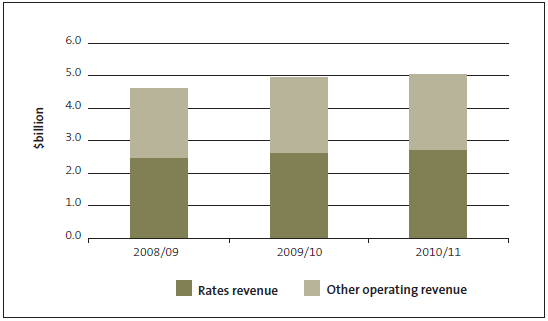
3.15
Year on year, operating and rates revenue increased in both 2009/10 and 2010/11. However, the percentage increases in 2010/11 were less those in 2009/10. In 2009/10, operating revenue increased 6.7%, while rates revenue increased by 6.2%. In 2010/11, operating revenue increased by 2%, while rates revenue increased by 4%.
3.16
Other than rates, the other major sources of revenue in 2010/11 include New Zealand Transport Agency subsidies of 14.6%, or $933 million, and development contributions and vested assets10 of 3.8%, or $243 million.
3.17
The proportion of operating revenue from development contributions and vested assets has fallen since 2009/10. This is what we expected to see, because the recession has slowed growth during the last few years.
3.18
Figure 5 shows the local authorities' operating revenue compared to their budget (including Auckland Council and Christchurch City Council), for the last two years. The operating revenue in 2010/11 was 3.0% ($206 million) more than the amount that local authorities had budgeted.
Figure 5
Operating revenue – actual and budget in 2009/10 and 2010/11
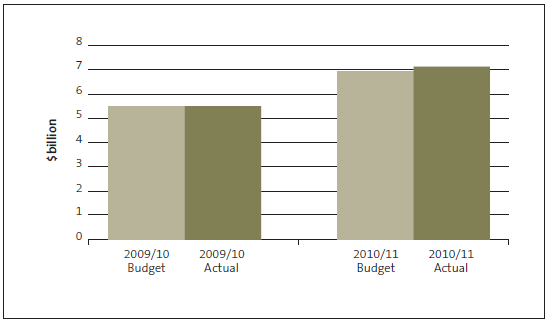
Operating expenditure
3.19
In 2010/11, the total operating expenditure for local authorities (excluding Auckland Council and Christchurch City Council) was $4.8 billion.11 This figure was $185 million greater than the equivalent figure in 2009/10.
3.20
Typically, we compare operating expenditure with two indices the annual consumer price index (CPI) and the local government cost index (LGCI). The CPI to June 2011 increased by 5.3% (which included a 2.3% increase in the December 2010 quarter, when GST rose from 12.5% to 15%).12 In their LTPs and annual plans, local authorities typically apply the LGCI to forecast their expenditure, rather than the CPI. The LGCI includes a general goods and services index, the transport capital expenditure index, and the "three waters" (wastewater, storm water, and freshwater) capital expenditure index. Therefore, the LGCI is a more accurate measure of costs local authorities face than is the CPI. The LGCI increased by 2.3% in the year to June 2011, and is forecast to increase by 5.3% in the year to June 2012.13
3.21
Figure 6 compares local authorities' actual operating expenditure to budget (including Auckland Council and Christchurch City Council) for the last two years. The actual 2010/11 expenditure was 6.8% ($432 million) more than the amount that local authorities had budgeted.
3.22
In 2010/11, depreciation and amortisation expenses were about 14.6% or $1.1 billion, and interest expenses were $409 million, or 6.7% of operating expenditure.
Figure 6
Operating expenditure – actual and budget in 2009/10 and 2010/11
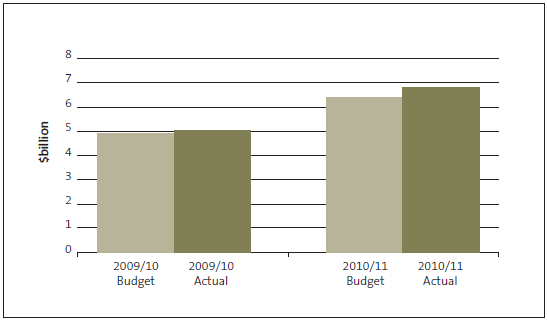
3.23
Of the $432 million increase on the amount that was budgeted for:
- $275 million was because of the effect of the earthquakes on Christchurch City Council's financial statements;14
- $98 million was from Auckland Council (where interest expenses and impairment of investments in subsidiaries were $90 million more than budget;15 and
- $24 million was from an increase in Wellington City Council's leaky home liability provision.
Cash flows
3.24
The cash flow statement consists of three items – net cash flows from:
- operating activities, which reflect the usual day-to-day business activities;
- investing activities, which reflect the buying and disposing of long-term assets and other investments; and
- financing activities, which reflect changes in borrowings and equity.
3.25
Figure 7 shows net cash flows from operating, investing, and financing activities from 2008/09 to 2010/11 (excluding Auckland Council and Christchurch City Council). Net cash flows from operating and investing activities increased during the three years. The negative figures show that more money was going out, which was mainly because the local authorities were acquiring long-term assets.
Figure 7
Net cash flows from 2008/09 to 2010/11
| Net cash flow | 2008/09 ($million) |
2009/10 ($million) |
2010/11 ($million) |
|---|---|---|---|
| From operating activities | 1,024 | 1,095 | 1,218 |
| From investing activities | (1,598) | (1,630) | (1,692) |
| From financing activities | 547 | 546 | 511 |
Capital expenditure
3.26
Local authorities spent $1.7 billion16 on capital work (excluding Auckland Council and Christchurch City Council) in 2010/11. This was an increase of 1.6%, or $27 million, on 2009/10 (see Figure 8).
Figure 8
Capital expenditure from 2008/09 to 2010/11

3.27
Figure 9 compares local authorities' (including Auckland Council's and Christchurch City Council's) actual spending on capital to the amount that they had budgeted. In general, capital expenditure includes paying for new assets to meet additional demand or improve service, or replacing (or renewing) assets. In 2010/11, local authorities spent 20.8% ($568 million) less on capital than the amount they had budgeted. (For 2009/10, the figures were 22.3% or $545 million less than budget.)
Figure 9
Capital expenditure – actual and budget in 2009/10 and 2010/11

3.28
Many of the local authorities' annual reports do not effectively disclose why they spent less than budget. It could be that efficiencies were made on completed projects. However, it appears that many local authorities either deferred or reprioritised their planned capital expenditure. In our view, it is important that local authorities are transparent about their reasons for the difference between planned and actual capital expenditure.
3.29
We discuss the relationship between capital expenditure and depreciation in paragraphs 3.53-3.57.
Debt
3.30
Local authorities use debt mainly to pay for long-life assets. In general, this is considered to be fairer than alternatives because it shares the cost of the assets among different generations of ratepayers. In general, local authorities should not borrow money to fund their operations.
3.31
Local authorities (excluding Auckland Council and Christchurch City Council) had debt of $4.1 billion as at 30 June 2011.17 Their total assets were $68 billion. Debt needs to be consistent with affordability considerations and what ratepayers expect to pay.
3.32
Figure 10 shows that local authorities continue to increase their debt – the total has increased by 14.7% since June 2010. The amount borrowed has been increasing since 2009. The local authorities with the largest debt increases were those with high population growth.
Figure 10
Local authorities' debt 2009-2011
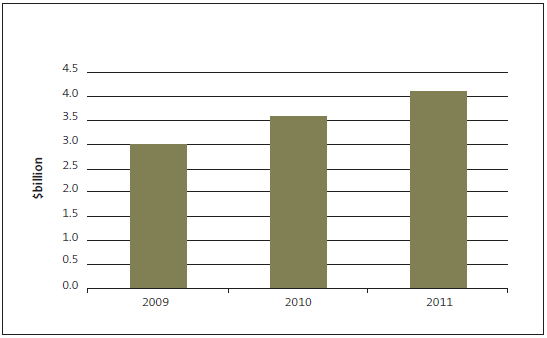
Note: As at 30 June each year. Excluding Auckland Council and Christchurch City Council.
3.33
In 2010/11, the average interest rate on debt was 5.7%.
3.34
Figure 11 shows local authorities' (including Auckland Council's and Christchurch City Council's) debt balance during the last two years compared to budget. As of 30 June 2011, local authorities had $202 million less debt than they expected to have. (On 30 June 2010, they had $526 million less debt than budget.) As at 30 June 2011, nine local authorities had no debt.
Figure 11
Debt – actual and budget in 2010 and 2011
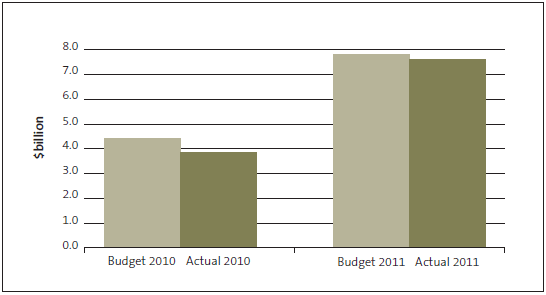
3.35
In Figure 11, the 30 June 2011 amounts include Auckland Council, but the 30 June 2010 figures exclude the previous eight Auckland local authorities. Auckland Council's 30 June 2011 budgeted debt for the eight-month period was $2.7 billion compared to actual debt of $3.0 billion. The total debt for local authorities (excluding Auckland Council) for 30 June 2011 was $4.6 billion, which was less than the $5.1 billion budgeted.
3.36
In our 2010 report, Matters arising from the 2009-19 long-term council community plans, we noted that local authorities were planning to use debt more. This increasing use of debt has been evident since 2004. We have reported the amounts that were borrowed externally. Where a local authority has accumulated (cash) reserve funds, it will use those funds if, from a debt-servicing perspective, it is more advantageous than borrowing externally.
3.37
Debt continues to be an important tool in managing local authority finances and is an important means of achieving the statutory goal of inter-generational equity. Using debt to buy an asset is seen as a way to equitably apportion the capital cost of an asset to the generations of ratepayers who will use the asset.
3.38
Prudently using debt can help to avoid large increases in rates, which might result when an asset is paid for in the year of its construction.
3.39
The economic environment affects how councils seek to use debt. With the continuing effect of the global financial crisis, we are starting to see that some councils plan to rely less on debt. In general, this means revised, delayed and/or reduced capital expenditure. Other councils continue to rely on debt and, in some cases, have extensive capital programmes to fund.
3.40
It is clear from the strategies that we have seen in LTPs that local authorities know that they must be able to justify why they raise debt. Debt for capital projects is justifiable if it provides a benefit exceeding the cost.
3.41
We intend to analyse all 2012-22 LTPs and report later this year. We will specifically review the combined picture of rates, debt, development contributions and financial strategies.
3.42
At the time of writing, about 18 local authorities have joined New Zealand Local Government Funding Agency Limited (the LGFA).18 In their 2012-22 LTPs, more local authorities indicate they may join the LGFA. These local authorities expect to pay lower interest rates than now and reduce their borrowing costs. The LGFA will also be able to borrow in foreign currency. Under the Local Government Act 2002, this option is not directly available to a local authority.19 The local government sector and Parliament will be interested to see whether the participating local authorities reduce their borrowing costs. We intend to include this information in future reports to Parliament.
Indicators of financial sustainability
Local authorities' debt to total revenue (excluding Auckland Council and Christchurch City Council)
3.43
The percentage of debt to total revenue compares borrowings (current and non-current) at year-end to total annual operating revenue. The higher the percentage, the less able the local authority is to cover its borrowing from the revenue it generates.
3.44
Overall, local authorities' debt to total revenue increased from 72% in 2009/10 to 81% in 2010/11 (see Figure 12). The increase reflects the increase in debt that local authorities hold.
Figure 12
Debt to total revenue, 2009-2011
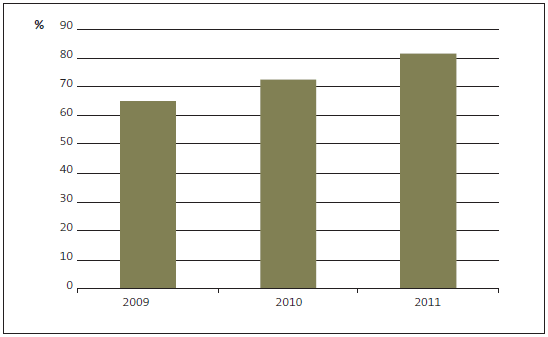
Note: Excluding Auckland Council and Christchurch City Council. Debt as at 30 June each year compared with revenue in the 12 months to that date. When Auckland Council and Christchurch City Council are included, the proportion of debt to revenue in 2011 was 194%. Auckland Council had a proportion of debt to revenue of 225%.
Debt to total assets (including Auckland Council and Christchurch City Council)
3.45
The proportion of debt relative to total assets indicates a local authority's debt-loading risk. A percentage of more than 100% means that a local authority has more debt than the value of its assets.
3.46
As at 30 June 2011, local authorities' proportion of debt to total assets was 7%. This was slightly higher than the 30 June 2010 figure of 5% (see Figure 13).
Figure 13
Debt to total assets, 2009 to 2011
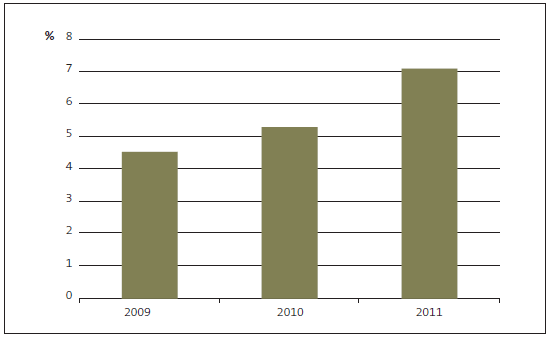
Note: As at 30 June each year. Auckland Council and Christchurch City Council are included.
3.47
Local authorities typically have a large base of long-term assets, so we expect them to have a low proportion of debt to total assets. Nine local authorities had no debt as at 30 June 2011. The highest proportion of debt to total assets was 15%. It is worth noting that many local authority assets are not realisable because they are infrastructure, such as roads and water supply, wastewater, and storm water systems.
Self-financing (excluding Auckland Council and Christchurch City Council)
3.48
The self-financing ratio compares net cash flow from operating activities to total revenue. The higher the ratio, the higher the internally generated surplus a local authority has to fund investing activities, such as buying long-term assets.
3.49
Figure 14 shows local authorities' self-financing ratio from 2008/09 to 2010/11.
Figure 14
Self-financing ratio, 2008/09 to 2010/11
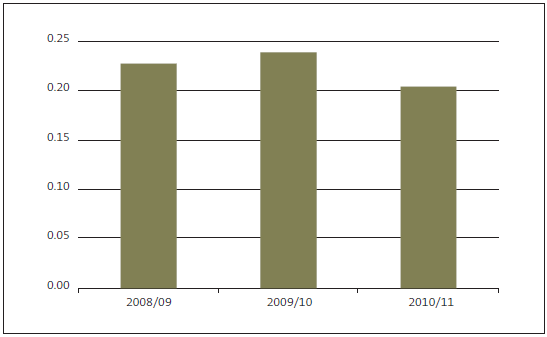
Note: The ratios shown in Figure 14 exclude Auckland Council and Christchurch City Council. Including those two local authorities, the 2010/11 self-financing ratio was 0.15:1. Christchurch City Council had a self-financing ratio of -0.7:1.
3.50
The highest ratio was 0.97:1 and the lowest was 0.02:1.
3.51
Christchurch City Council (not included in these results) was the only local authority with a negative self-financing ratio. A negative operating cash-flow result is rare for local authorities. Christchurch City Council reported in its annual report that:
After adjusting for non-cash items we have made a cash operating deficit for the year of $30.1 million compared to the planned surplus of $131.5 million. The difference between the planned surplus and actual deficit is essentially the result of earthquake-related payment to suppliers. This has been funded by reducing Council expenditure on the capital programme, the receipt of insurance proceeds, and through the use of funds Council previously had invested.20
Capital expenditure relative to depreciation (excluding Auckland Council and Christchurch City Council)
3.52
The capital expenditure to depreciation ratio compares the rate of capital expenditure on assets to depreciation. A ratio higher than 1:1 shows that capital expenditure is higher than the depreciation rate, and suggests a level of reinvestment that is maintaining or improving the assets' performance capability, and improving the nature of the service that the assets provide.
3.53
This ratio is a long-term indicator, because capital expenditure can be deferred. Therefore, the indicator needs to be considered over several years as well as in any one year.
3.54
Figure 15 shows that the average capital expenditure to depreciation ratio for 2010/11 was 1.77:1 (2009/10: 1.78:1). We note that 16 local authorities had a ratio less than 1:1. In 2009/10, 11 local authorities had a ratio less than 1:1.
Figure 15
Capital expenditure relative to depreciation, 2008/09 to 2010/11
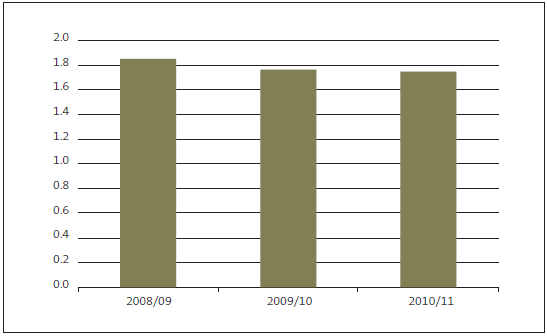
Note: The ratios exclude Auckland Council and Christchurch City Council. Including those two local authorities, the capital expenditure to depreciation ratio was 1.78:1.
3.55
We plan to collect information on how much local authorities invest in new capital projects compared with how much they spend on assets through renewal or replacement. We cannot easily extract this information from local authorities' audited financial statements.
3.56
The Local Government Act 2002, as amended in 2010, includes a requirement for local authorities to disclose in their LTP the capital that they have budgeted to meet additional demand, to improve the level of service, or to replace existing assets.21 The Act requires a local authority to report its capital expenditure in its annual report. The annual report should also include reasons for variations of actual expenditure over or under budget.
Liquidity (including Auckland Council and Christchurch City Council)
3.57
Figure 16 shows that the overall liquidity ratio for the local authority sector was 0.70:1 at 30 June 2011. The liquidity ratio compares current assets to current liabilities. It measures whether a local authority has enough resources to pay what it owes during the next 12 months without having to borrow further.
Figure 16
Local authorities' liquidity ratio, 2009 to 2011
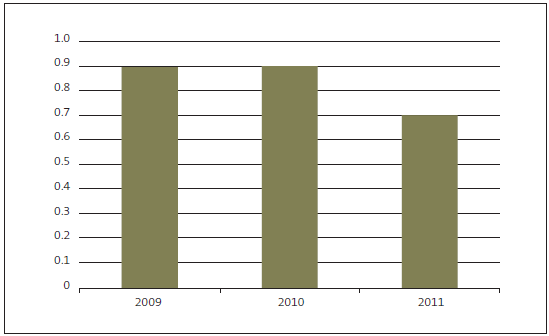
3.58
On 30 June 2011, the highest liquidity ratio for any local authority was 13.70:1 (at 30 June 2010, the equivalent ratio was 11.81:1) and the lowest was 0.10:1 (in 2010, the equivalent ratio was 0.16:1). In general, regional councils had a higher liquidity ratio than city and district councils.
3.59
The (often) low liquidity ratios for city and district councils reflect their debt profiles. Much debt is recorded as current because of how local authorities structure their loan renewals and their use of cash reserves (through internal borrowings) to fund capital expenditure before borrowing externally.
3.60
A ratio of less than 1:1 indicates that an organisation could have difficulty in meeting its liabilities, when they fall due, by using its current assets. The liquidity ratios achieved by local authorities are in line with those budgeted or anticipated in the local authorities' 2009-19 LTPs, reflecting that this is typical of how the local authority sector structures it debt. Most local authorities foresee few problems rolling over or renewing their loans.
Group financial information
3.61
We have considered the group financial information for city councils. Group financial information includes the financial information of the city council and of its council-controlled organisations (CCOs).
3.62
Each local authority structures its business differently. Some, such as Christchurch City Council and Auckland Council, have large group structures with several CCOs. Napier City Council and Porirua City Council have no CCOs. Some local authorities have CCOs that run core operations. For example, the statutory reorganisation of the Auckland Council group resulted in some of its CCOs running major activities and services – including water supply, wastewater, and transport. Other CCOs are held as local authority investments. A local authority must consult with its community before setting up or investing in a CCO.
3.63
The 13 parent city councils collected $3.7 billion in revenue. The CCOs collected a further $1.4 billion, of which the CCOs of Auckland Council and Christchurch City Council collected 86%, or $1.2 billion.
3.64
The parent city councils spent $3.5 billion, and the CCOs spent a further $1.4 billion. Of that $1.4 billion, the CCOs of Auckland Council and Christchurch City Council spent 86%, or $1.2 billion.
3.65
The 13 parent city councils' capital expenditure was $1.1 billion during 2010/11. CCOs spent a further $0.8 billion. The CCOs of Auckland Council and Christchurch City Council spent almost 92%, or $0.7 billion, of that $0.8 billion.
3.66
As at 30 June 2011, the city councils' CCOs had assets of $5.4 billion. Of this, 70%, or $4.1 billion, was held by the CCOs of Auckland Council and Christchurch City Council. The parent city councils had assets of $62.7 billion. The assets of Auckland Council and Christchurch City Council total $38.6 billion.
3.67
The city council CCOs had debt of $1.8 billion. The CCOs of Auckland Council and Christchurch City Council held 83% of this, or $1.5 billion. The parent city councils had debt of $5.3 billion, of which Auckland Council and Christchurch City Council held $3.5 billion.
Reporting financial information in the 2012/13 annual reports
3.68
In 2012/13, changes will have taken effect that should help us to better observe local authorities' financial performance and financial position.
3.69
Section 101A of the Local Government Act 2002, as amended in 2010, requires a local authority to adopt a financial strategy that informs and guides the assessment of funding and expenditure proposals. Local authorities are preparing their LTPs for 2012-22 and are required to include a financial strategy for all of the financial years covered in them. Section 101A specifies particular items that must be included:
- quantified limits on rates;
- rate increases; and
- borrowing.
3.70
Although local authorities are not required to report against their financial strategy until their pre-election report, we plan to analyse the annual report data against local authorities' LTPs every year.
3.71
At the time of writing, some local authorities had adopted their "statement of proposal" for their 2012-22 LTPs and were consulting the public about their plans. We have seen a trend towards more spending and debt, although there is an emphasis on keeping rate increases close to the forecast increases in the LGCI. We have also seen that many local authorities are looking at when and how much they spend on capital to try to minimise the effect on rates and debt. However, when local authorities are deciding about spending, they must consider the effect their decisions might have on the services that they provide.
3.72
The Local Government (Financial Reporting) Regulations 2011 specify the information that a local authority's financial statements in the LTP, annual plan, and annual report should disclose. A local authority must also prepare funding impact statements using the format prescribed in the regulations. Because all local authorities have to prepare the funding impact statements in the prescribed format, this should make it easier to compare the financial information of local authorities.
5: The four-month results of the previous eight Auckland local authorities for the period ended 31 October 2010 are excluded from the 2010/11 results, and their full-year results have been excluded from the 2008/09 and 2009/10 comparative results.
6: "Impact of the 2010 and 2011 Canterbury earthquakes", Christchurch City Council 2010/11 Annual Report, pages 138-143.
7: Christchurch City Council and the four other local authorities listed in paragraph 3.9.
8: Including Auckland Council and Christchurch City Council, the total operating revenue was $7.1 billion.
9: Including Auckland Council and Christchurch City Council, the total rates revenue was $3.9 billion.
10: Vested assets are assets that are transferred to a local authority at nominal or zero cost. Typically, they might result from a situation where a developer has installed assets when developing a site and passes them to a local authority to manage, maintain, and deliver services through. The fair value of these assets has to be determined, because they are integrated into the local authority's asset information system so that they can be appropriately managed.
11: Including Auckland Council and Christchurch City Council, the total operating expenditure was $6.8 billion.
12: See www.stats.govt.nz.
13: Business and Economic Research Limited (2011), Forecasts of price level change adjustors – 2011 update, a note to Society of Local Government Managers and Local Government New Zealand, page 12.
14: "Impact of the 2010 and 2011 Canterbury earthquakes", Christchurch City Council 2010/11 Annual Report, page 143.
15: "Note 40 Explanation of major variances against budget", Auckland Council 2010/11 Annual Report, page 333.
16: Including Auckland Council and Christchurch City Council, capital expenditure was $2.2 billion.
17: Including Auckland Council and Christchurch City Council, the total borrowings were $7.6 billion and total assets were $106.5 billion.
18: The LGFA was established under the Local Government Borrowing Act 2011.
19: This prohibition excludes Auckland Council, which is able to borrow in foreign currency.
20: Christchurch City Council, 2010/11 Annual Report, page 125.
21: Schedule 10, clause 3 of the Act refers to a general requirement. The specific regulations that apply are the Local Government (Financial Reporting) Regulations 2011.
page top